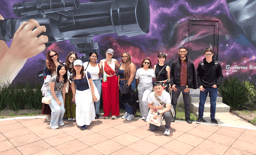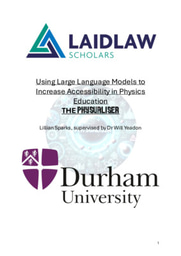Research Proposal - Utilising Large Language Models to Promote Accessibility in Physics Education
Research Question:
How can a Large Language Model (LLM) be developed and utilised to make introductory physics education more accessible and inclusive, particularly for students with learning differences such as ADHD and dyslexia?
Objectives:
- To develop a bespoke LLM that aligns with the Universal Design for Learning (UDL) framework to enhance accessibility in physics education.
- To tailor the LLM to provide clear, engaging, and personalised explanations of introductory physics concepts, catering to diverse learning needs.
- To evaluate the effectiveness of the LLM in improving understanding and engagement among students, particularly those with learning differences.
-
To create a user-friendly interface for easy access and use of the LLM by students and educators.
Summary for Non-Experts:
Physics, with its complex concepts and formulas, can be challenging for many students, especially those who learn differently due to conditions like ADHD or dyslexia. Traditional teaching methods might not cater to the needs of these students, leading to a gap in understanding and interest. My project aims to bridge this gap using a technology known as a Large Language Model (LLM).
An LLM is a type of artificial intelligence that can understand and generate human-like text. You might have heard of some LLMs like GPT-4, used in applications such as chatbots. In this project, we plan to develop a special LLM specifically for teaching introductory physics. Unlike a general chatbot, this LLM will be like a virtual tutor, capable of explaining physics concepts in a way that is easy to understand and engaging, regardless of a student's learning style.
The project will follow these steps:
- Development: I will start by building the LLM, making sure it knows a lot about physics and how to explain it simply. I will also ensure that it follows principles of inclusive education, which means it should work well for all students, including those with ADHD or dyslexia.
- Testing and Evaluation: Once the LLM is ready, I will test it. I want to see how well it helps students understand physics compared to traditional methods.
- Making it User-Friendly: It's important that this tool is easy to use. So, I will create an interface (like an app or a website) where students can interact with the LLM, ask questions, and get explanations.
- Sharing the Findings: I will write a detailed report about how I built the LLM, how well it worked, and what students thought about it. This report can help other educators and technologists who are interested in using AI to make learning better and more inclusive.
By the end of this project, I hope to have a working virtual tutor that can make learning physics more accessible and enjoyable for all students, especially those who find traditional learning methods challenging. This project isn’t just about using a cool new technology; it's about making sure that everyone has the same opportunity to learn and love physics.



Please sign in
If you are a registered user on Laidlaw Scholars Network, please sign in